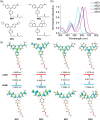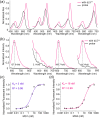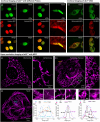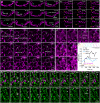Azetidinyl Malachite Green: a superior fluorogen-activating protein probe for live-cell and dynamic SIM imaging
- PMID: 40336989
- PMCID: PMC12053737
- DOI: 10.1039/d5sc01150g
Azetidinyl Malachite Green: a superior fluorogen-activating protein probe for live-cell and dynamic SIM imaging
Abstract
Malachite Green (MG) and its fluorogen-activating protein (FAP) pair are valuable tools for live-cell and super-resolution fluorescence imaging due to their unique near-infrared absorption and signal enhancement. However, the low brightness and photostability of MG have limited its use in dynamic imaging. In this study, we introduce a novel derivative, azetidinly Malachite Green (Aze-MG), which enhances the brightness of the MG-FAP complex by 2.6-fold. This enhancement is achieved by replacing the N,N-dimethylamino group in MG with an azetidine group, which suppresses the twisted intramolecular charge transfer (TICT) effect, leading to improved quantum yield and photostability. Additionally, the reduced binding affinity of Aze-MG for FAP enables a buffering strategy, allowing the reversible exchange of photobleached fluorogens with free fluorogens, thereby ensuring stable fluorescence over time. This combination of improved brightness and buffering capability makes Aze-MG an ideal probe for live-cell and dynamic SIM imaging.
This journal is © The Royal Society of Chemistry.
Conflict of interest statement
There are no conflicts to declare.
Figures






Similar articles
-
Developing Bright Green Fluorescent Protein (GFP)-like Fluorogens for Live-Cell Imaging with Nonpolar Protein-Chromophore Interactions.Chemistry. 2021 Jun 21;27(35):8946-8950. doi: 10.1002/chem.202101250. Epub 2021 May 21. Chemistry. 2021. PMID: 33938061
-
Fluorogen-activating single-chain antibodies for imaging cell surface proteins.Nat Biotechnol. 2008 Feb;26(2):235-40. doi: 10.1038/nbt1368. Epub 2007 Dec 23. Nat Biotechnol. 2008. PMID: 18157118
-
Rapid, specific, no-wash, far-red fluorogen activation in subcellular compartments by targeted fluorogen activating proteins.ACS Chem Biol. 2015 May 15;10(5):1239-46. doi: 10.1021/cb500957k. Epub 2015 Feb 16. ACS Chem Biol. 2015. PMID: 25650487 Free PMC article.
-
Fluorogen-Activating Proteins: Next-Generation Fluorescence Probes for Biological Research.Bioconjug Chem. 2020 Jan 15;31(1):16-27. doi: 10.1021/acs.bioconjchem.9b00710. Epub 2019 Dec 13. Bioconjug Chem. 2020. PMID: 31789501 Review.
-
Fluorogen-activating proteins: beyond classical fluorescent proteins.Acta Pharm Sin B. 2018 May;8(3):339-348. doi: 10.1016/j.apsb.2018.02.001. Epub 2018 Mar 24. Acta Pharm Sin B. 2018. PMID: 29881673 Free PMC article. Review.
References
-
- Daugird T. A. Shi Y. Holland K. L. Rostamian H. Liu Z. Lavis L. D. Rodriguez J. Strahl B. D. Legant W. R. Correlative single molecule lattice light sheet imaging reveals the dynamic relationship between nucleosomes and the local chromatin environment. Nat. Commun. 2024;15:4178. doi: 10.1038/s41467-024-48562-0. - DOI - PMC - PubMed
-
- Kozma E. Kele P. Fluorogenic probes for super-resolution microscopy. Org. Biomol. Chem. 2019;17:215–233. - PubMed
LinkOut - more resources
Full Text Sources
Miscellaneous

